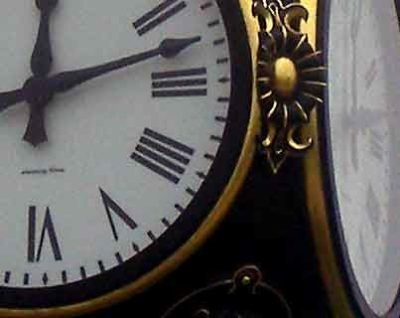Clocks and Time
This is an extensive illustrated discussion of the topic.
Introduction
The following is an edited compendium of various theories, primarily postings to the Clocks Mailing List and to the alt.horology newsgroup in 1995-6 concerning why the Roman IIII is used instead of IV on clock dials.
W. I. Milham:
“There is a story that a famous clockmaker had constructed a clock for Louis XIV, king of France. The clockmaker had naturally used IV for four. When the clock was shown to the king, he remarked that IIII should have been used instead of IV. When it was explained to him that IV was correct, he still insisted, so that there was nothing to do but change the clock dial. This introduced the custom of using IIII for four. This is probably only a story, however, as IIII occurs long before the time of Louis XIV. And this same story is also told in connection with other monarchs. There is one reason why IIII is preferable to IV, and it may have caused the change. On the other side of the clock dial the VIII is the heaviest number, consisting of four heavy strokes and one light one, as it is usually made. It would destroy the symmetry to have the IV with only two heavy strokes on the other side. Thus IIII with four heavy strokes is much to be preferred. The change may therefore have been made for reasons of symmetry.”
From Time & Timekeepers, W. I. Milham, The Macmillan Company, New York, 1947, p. 196:
Joerg Haus, alt.horology:
There was a long discussion about that in a German watch- magazine (‘Uhrenmagazin’, for those who may know it). The widely accepted argument for ‘4’ being displayed as ‘IIII’ and not as ‘IV’ (as it would be correct!) is the following: Imagine a watch face with roman numerals, and look at the numerals opposite to each other – all of them are in perfect balance, except for the ‘heavy’ VIII and the ‘light’ IV; optical balance is re-established by printing an also ‘heavy’ IIII. This may sound rather silly, but for a similar reason you’ll see many watches/clocks displayed on photographs with their hands showing 10:09; it’s simply the ‘most friendly’ clock face :).
Ray Mialki, alt.horology:
The reason isn’t all that far fetched. Using four I’s instead of IV for the “four” is due to the casting process of the numerals. Since some numerals were cast out of metal, or carved out of wood or bone, you need 20 I’s, 4 V’s, and 4 X’s, even numbers of each, if you use four I’s for “four”. The molds would produce a long centre rod, with 10 I’s, 2 V’s, and 2 X’s on each side.
Tom Frank, Clocks:
According to my high school Latin teacher (it was long enough ago that she may have been there personally), the reason clocks use IIII vice IV is out of respect for the Roman God Jupiter, whose name, in Latin, begins IV (the V being the U we now use, the I the J; sort of an abbreviation).
This convention would, of course, go back to the days of sundials (as an aside, I am also interested in them, mostly how best to make them…although living in New England they don’t work very well!), and in my travels I have never seen a sundial made prior to the 19th century
which had IV on it, always IIII. Sounds just odd enough she might have been right. Any ancient Roman/Greek scholars out there to offer some further insight?
Jeffrey A. Harvey:
This is trivial, but some of you might not have noticed… On Roman clock faces, “IIII” is often used in place of “IV” for the “4 o’clock” (excuse me… 04:00 or 16:00 per ISO9000 🙂 !). This is apparently because “IV” is an abbreviation for “Jupiter” in Roman times. So they decided to use “IIII” so that their public clocks didn’t have “1 2 3 GOD 5…” written on them.
Alan Heldman, alt.horology:
Yes, all of those theories have been mentioned. But the one not mentioned in the last post is the one that strikes me (four times) as the most likely: Classicists who have studied old Roman inscription of marble monuments etc. say that IIII was very often, perhaps predominantly, the form that was used in classical times. In a book picturing hundreds of tower clock dials, I found that about 95+% of them were in the IIII form. Interestingly, though, the most famous tower clock in the world, Big Ben, uses the IV form. There is also a hypothesis that the first clocks to use the IV form were clocks which had the rare feature of “Roman Striking.” This used two bells, a higher pitch bell representing a one and a lower pitch bell representing a five. Thus four o’clock would be struck by one stroke of the small bell followed by one stroke of the big bell; six would be struck by one stroke of the big bell followed by one stroke of the small bell. This is a very efficient system, but died out almost entirely in the early 18th c..
Guus van Pelt
Like so many others I wondered about the presentation of the number four on roman dials. I think that there might be another explanation for using the IIII form, an explanation I have never read so far. What about the simple explanation that using IIII would build a dial that has four hour-indications using a I; four indications that use a V and four indications that use an X. Isn’t that beautiful and symmetrical?
Copyright © 1996,1999, 2002 Gordon T. Uber Updated 23 April 2002
